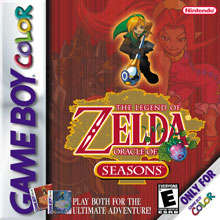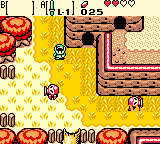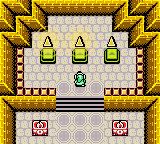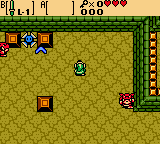

Title: |
|
Genre: |
|
|
Developer: |
|
|
Publisher: |
|
Release Date: |
|
On Wikipedia: |
|
Systems: |
|
Developer d/b/a: |
|
I originally wrote this back in August 2015 and it did need a rewrite as a lot of things are rather out of date.
You know a game is very good or very bad when it invokes so many memories in you. Well, I've had some less-good games with strong memories (more on that later), but The Legend of Zelda: Oracle of Seasons is one of those good ones. Now this Zelda quest on the Game Boy Color was co-developed by Capcom (more accurately, their studio Flagship), but that doesn't matter, it's still awesome.
Today, it's a somewhat grim Supercenter, but back in the day, I got distracted at the local Wal-Mart's (as it was known back then) electronics department with a new Game Boy Color game that looked a bit like The Legend of Zelda: Link's Awakening. To make a long story short, my dad blamed me for "running off" and I really got it...but Oracle of Seasons still made an impression on me.

It's autumn in Holodrum.
While it WAS my brother who actually bought the game, it was ME who got the less-expensive but not less interesting companion, the Official Nintendo Player's Guide of the game and its sister game, The Legend of Zelda: Oracle of Ages, which had compatibility with it. The guide is a masterfully written piece of work with colorful maps, clear appendices where the Pieces of Hearts, items (between the two games, lots of them), and rings (exclusive to the Oracle series) were. The Prima guides never stacked up, and at least one third-party guide didn't even cover that pesky statue-moving puzzle in Poison Moth's Lair. There are a few minor areas where the guide doesn't cover clearly or at all. These include which old men on the map give you Rupees and which take them, getting Moosh's Flute or Dmitri's Flute (by default, you get Ricky's Flute), and a few other things.
The story in Oracle of Seasons is that Link (who may or may not be the same Link from the then-relatively modern Ocarina of Time, though was later canonized to take place after A Link to the Past) is transported by the Triforce to a new land, the land of Holodrum, where he meets Din the dancer (not the goddess, but rather secretly an seasons-controlling oracle). Soon after, he finds himself alone in a winter landscape with only Impa (not the badass woman warrior from Ocarina of Time, here, she's a plump matron) sending him off on his quest. Onox, a new foe, has captured Din in a crystal with his stronghold north of town, and you have to rescue her after beating some eight dungeons (standard, I know).

You win? No, this is before you even press START.
Unlike the rather disappointing DS quests, the dungeons are great. While the boss music for the dungeons is a bit cheesy, it isn't a dealbreaker. The first one is Gnarled Root Dungeon, an homage (in more ways than one) to the first dungeon in the original The Legend of Zelda (which makes sense, seeing as how early in the development process one of the three games, which became two, was supposed to be a remake of the NES classic), though it includes new features not seen in Link's Awakening, like mine cart tracks. The second, Snake's Remains (yes, that's the name of the dungeon) is after you collect the Rod of Seasons, and gain the power of Winter in the underworld of Subrosia (yes, it's that kind of game). Then you meet (and jump in the pouch) of a kangaroo with boxing gloves and gain the power of Summer (you need a tree stump to change the seasons). The third is Poison Moth's Lair, which contains one of the most challenging puzzles of the game (Oracle of Seasons isn't big on puzzles, it's more on action), then defeat a bomb-throwing Moblin, collect the power of Spring, and it's off to the fourth dungeon, Dancing Dragon Dungeon, which ironically has no dragons (though it does have some more minecart puzzles, some rockin' music, and disappearing platforms). Then, after getting the last season, Autumn, it's off to the Unicorn's Cave (a dungeon that makes use of the new Magnetic Gloves), then Ancient Ruins (a five-level dungeon that involves one-way turnstiles), Explorer's Crypt (one where you get the "Roc's Cape" but otherwise forgettable), and then Sword & Shield Maze (a fire 'n' ice dungeon).

Dungeon rooms are much larger in the Oracle series rather than Link's Awakening.
I loved the Player's Guide for this game and have had some fond memories of Florida vacations (no Disney) playing the game, once in 2001 and once in 2004 (the latter Panama City Beach—mentioned on this page). I remember finding out in person that the Magunesu are probably the most annoying enemies in the game. Despite their cuddly appearance, they are irritating, as they constantly shoot fireballs, switch magnetic polarity so they always fly away from your new Magnetic Gloves, so you have to attract them, swat at them with your sword (they take several hits to kill), and then do all that before they fly away again (this was the screenshot I wanted to get). I also found, beating Onox took a bit of practice, but once you got down the hopping on the claw coming down and jumping to hit the gem on the forehead, he went down smoother than a glass of cold lemonade.
FINAL RATING: 